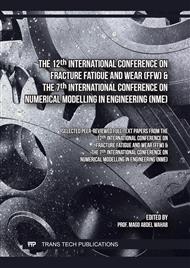[1]
A.E. Zaghi, J.E. Padgett, M. Bruneau, M. Barbato, Y. Li, J. Mitrani-Reiser, A. McBride, Establishing common nomenclature, characterizing the problem, and identifying future opportunities in multihazard design, J. Struct. Eng. 142 (12) (2016) H2516001.
DOI: 10.1061/(asce)st.1943-541x.0001586
Google Scholar
[2]
M. Francioli, F. Petrini, F. Bontempi, Structural robustness analysis of RC frames under seismic and blast chained loads scenarios, Journal of Building Engineering 67 (2023) 105970.
DOI: 10.1016/j.jobe.2023.105970
Google Scholar
[3]
Himoto, K., 2019. Comparative analysis of post-earthquake fires in Japan from 1995 to 2017. Fire Technol. 55 (3), 935–961.
DOI: 10.1007/s10694-018-00813-5
Google Scholar
[4]
Risco, G.V., Zania V., Giuliani L., 2023. Numerical assessment of post-earthquake fire response of steel buildings Giuliani, Safety Science 157 (2023) 105921
DOI: 10.1016/j.ssci.2022.105921
Google Scholar
[5]
Chicchi, R., Varma, A., 2018. Research review: post-earthquake fire assessment of steel buildings in the United States. Adv. Struct. Eng. 21 (1), 138–154.
DOI: 10.1177/1369433217711617
Google Scholar
[6]
Della Corte, G., Landolfo, R., Mazzolani, F., 2003. Post-earthquake fire resistance of moment resisting steel frames. Fire Saf. J. 38, 593–612.
DOI: 10.1016/s0379-7112(03)00047-x
Google Scholar
[7]
Nishino, T. 2023. Post-earthquake fire ignition model uncertainty in regional probabilistic shaking–fire cascading multi-hazard risk assessment: A study of earthquakes in Japan. International Journal of Disaster Risk Reduction 98 (2023) 104124
DOI: 10.1016/j.ijdrr.2023.104124
Google Scholar
[8]
Covi, P., Tondini, N., Sarreshtehdari, A., Elhami-Khorasani, N. 2023. Development of a novel fire following earthquake probabilistic framework applied to a steel braced frame. Structural Safety 105 (2023) 102377
DOI: 10.1016/j.strusafe.2023.102377
Google Scholar
[9]
P. Fajfar, P. Gaspersic, The N2 method for the seismic damage analysis of RC buildings, Earthquake Engineering and Structural Dynamics, vol. 25, (1996) 31-46.
DOI: 10.1002/(sici)1096-9845(199601)25:1<31::aid-eqe534>3.0.co;2-v
Google Scholar
[10]
CEN, European Committee for Standardization, Eurocode 8: Design of structures for earthquake resistance – Part 1: General rules, seismic actions and rules for building. European Standard EN 1998-1-2004, CEN, Brussels, 2004.
DOI: 10.3403/03244372
Google Scholar
[11]
A. H. Buchanan, A. Kwabena Abu, Structural design for fire safety, John Wiley & Sons, 2017.
Google Scholar
[12]
H. Liang, GeniSTELA - A Generalised Engineering Methodology for Thermal Analysis of Structural Members in Natural Fires, 2008.
Google Scholar
[13]
F. Bontempi, A. Aguinagalde, F. Petrini, Progettazione strutturale antincendio. Come sviluppare analisi strutturali e verifiche di sicurezza in caso di incendio, Flaccovio Editore, Palermo, 2021.
Google Scholar
[14]
EN 1992-1-2 (2004) (English): Eurocode 2: Design of concrete structures - Part 1-2: General rules - Structural fire design [Authority: The European Union Per Regulation 305/2011, Directive 98/34/EC, Directive 2004/18/EC.
Google Scholar
[15]
CEN, European Committee for Standardization, Eurocode 3 Design of steel structure – Part 1–2: General rules, Structural fire design. European Standard EN 1993-1-2, CEN, Brussels, 2005.
Google Scholar
[16]
Italian Ministry for Transportations and Infrastructures (2018) Norme Tecniche per le Costruzioni (NTC2018) – Technical Standards for Structures.
Google Scholar


